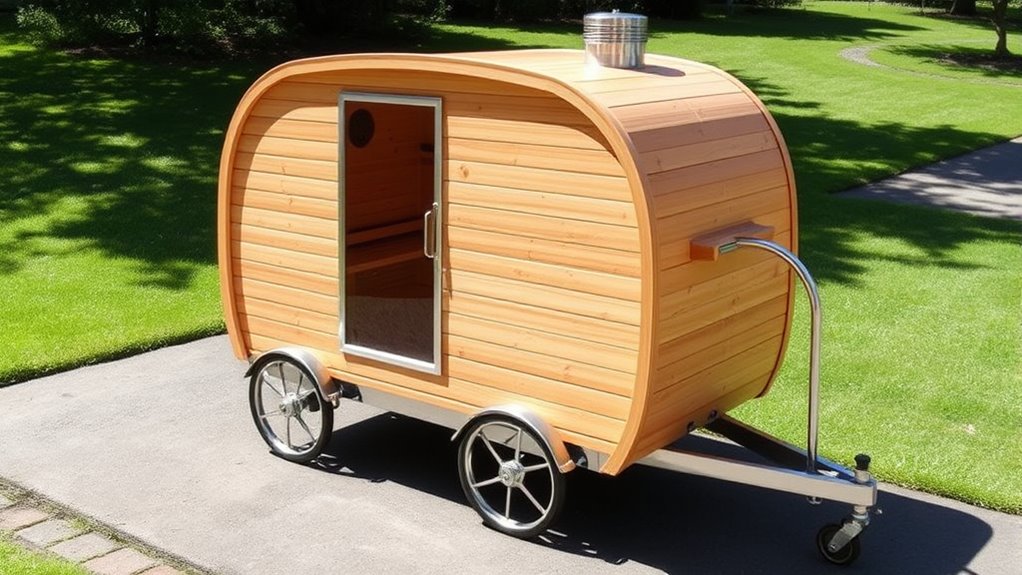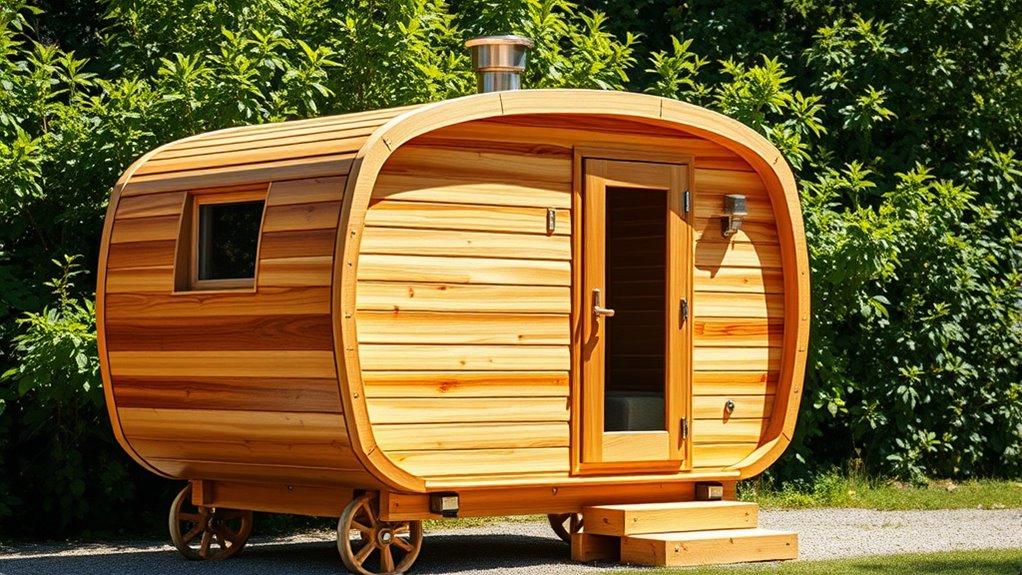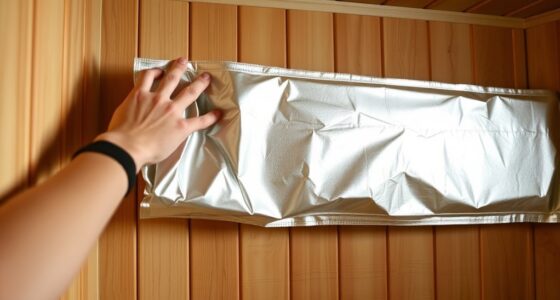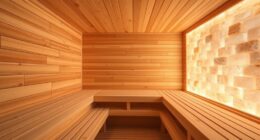To build a portable sauna on wheels, start with a lightweight, durable exterior like aluminum or reinforced plywood, suitable for outdoor use. Insulate well using mineral wool or reflective foil to keep the heat in efficiently, and choose a safe, suitable heat source such as an electric or wood-burning heater. Make certain your design includes ventilation, easy water access, and secure wheels for mobility. For detailed steps and tips, you’ll discover essential ideas that help you create a convenient, enjoyable mobile sauna experience.
Key Takeaways
- Select lightweight, durable exterior materials like aluminum or reinforced plywood for easy transport and weather resistance.
- Incorporate effective insulation such as mineral wool or reflective foil to maintain heat and energy efficiency.
- Choose a suitable heat source, like electric or propane, ensuring safety features and proper ventilation are in place.
- Design a compact, wheeled frame with secure attachment points for mobility and stability during transit.
- Include accessible water supply and ventilation systems to ensure safety, comfort, and efficient steam generation.

Creating a portable or mobile sauna on wheels gives you the freedom to enjoy a relaxing steam session wherever you go. Whether you’re heading to the countryside, setting up at a festival, or simply want the convenience of a sauna in your backyard, building a mobile sauna can be both practical and rewarding. The key to making this work efficiently starts with proper sauna insulation. You need insulation that retains heat effectively while remaining lightweight enough for transport. Materials like mineral wool, foam board, or reflective foil insulation are excellent choices because they provide high thermal resistance without adding unnecessary bulk. Proper insulation not only helps your sauna heat up faster but also keeps the heat consistent during your session, ensuring you get the most benefit from your steam.
When considering heat source options, you have several viable choices. Electric heaters are convenient and easy to control, making them ideal if you have easy access to electricity. These heaters often come with digital controls, allowing you to set the temperature precisely and enjoy a consistent steam experience. Alternatively, wood-burning stoves add a traditional touch and can be highly effective, especially if you plan to use your sauna in remote locations without electricity. Just keep in mind that wood stoves require proper ventilation and safety precautions to prevent smoke buildup. Propane heaters are another option, offering portability and quick heating, but you’ll need to ensure proper ventilation for safe operation. Whichever heat source you choose, safety must be a priority, and you should always follow manufacturer instructions and local regulations.
Designing your mobile sauna also involves selecting durable, lightweight materials for the exterior, such as aluminum or reinforced plywood, which resist weather and wear. Don’t forget about ventilation; proper airflow is essential to prevent moisture buildup and ensure a comfortable sauna experience. You’ll also want to install a reliable power supply or battery system if you opt for electric heating, along with easy access to water for steam and rinsing down after your session.
Frequently Asked Questions
What Are the Best Materials for Insulation in a Mobile Sauna?
You should use high-quality mineral wool or foam board insulation for your mobile sauna. Aim for at least 2-3 inches of insulation thickness to guarantee proper heat retention. Don’t forget moisture barriers like vapor barriers or foil-faced insulation, which protect against humidity. Properly sealing seams and using moisture-resistant materials help maintain efficiency and prevent damage, making your portable sauna more comfortable and durable.
How Do I Ensure Safety During Transportation of the Sauna?
You might think transporting a sauna is as simple as a Sunday drive, but safety matters. To keep it secure, you’ll want to make certain all attachments are tight and stable, preventing any wild sauna rides. Don’t forget fire safety—install fire extinguishers and avoid overheating components. Double-check tie-downs, brakes, and weight limits. With these precautions, your mobile sauna will arrive safely, ready for relaxing sessions without any unexpected surprises.
What Size Should the Wheels and Chassis Be for Stability?
You should choose wheel size based on your sauna’s weight and dimensions, generally opting for larger wheels—around 12 to 16 inches—for better stability and easier maneuvering. Guarantee the chassis is proportionally sturdy, supporting the chassis weight comfortably without bending or cracking. A heavier sauna needs a stronger, wider chassis and larger wheels to distribute weight evenly, prevent tipping, and provide a smooth ride during transportation.
How Much Does It Typically Cost to Build a Mobile Sauna?
A typical cost estimate for building a mobile sauna ranges from $5,000 to $15,000, depending on size, materials, and features. You should include expenses for insulation, heating, and wheels in your budget planning. Keep in mind that customizations or high-end finishes can raise costs. By setting a clear budget, you can better manage expenses and choose options that fit your financial plan.
Are There Legal Restrictions for Mobile Saunas on Public Roads?
Did you know that over 60% of mobile structures face legal restrictions? When it comes to mobile saunas on public roads, you need to check parking regulations and licensing requirements in your area. Many regions restrict parking or operating mobile units without proper permits, so verify you comply to avoid fines or legal issues. Always consult local authorities before hitting the road with your portable sauna.
Conclusion
Now that you’ve built your portable sauna on wheels, you’re ready to take relaxation wherever life takes you. Think of it as your personal retreat on wheels, a cozy haven you can roll into your backyard, campsite, or seaside retreat. With a little effort, you’ve created a mobile oasis that turns any spot into a soothing sanctuary. So go ahead—hit the road and let your sauna adventures roll on, bringing warmth and wellness wherever you go.









